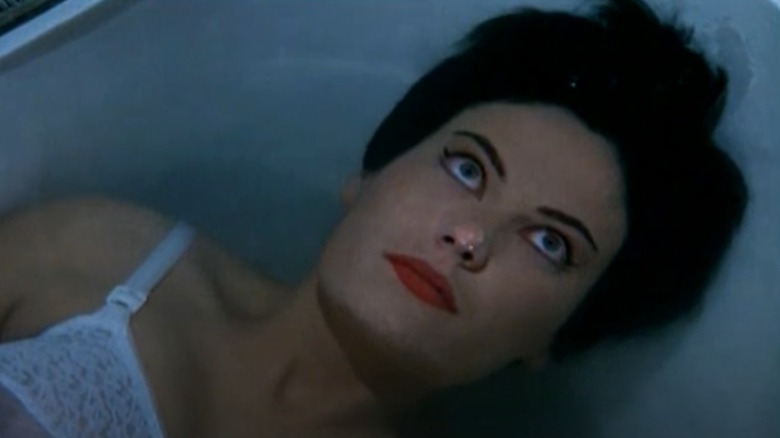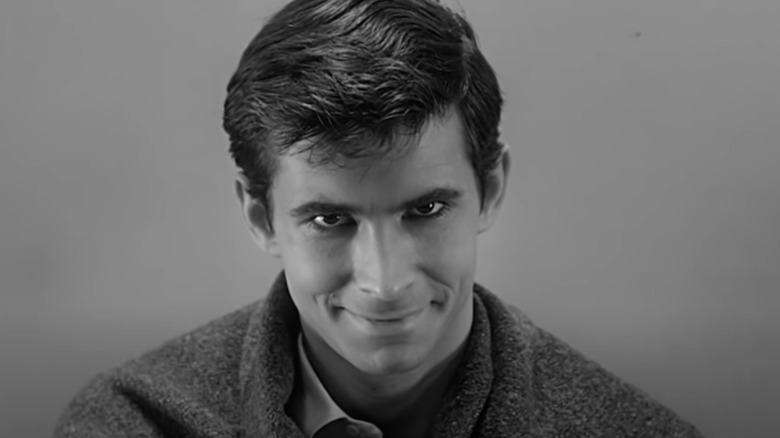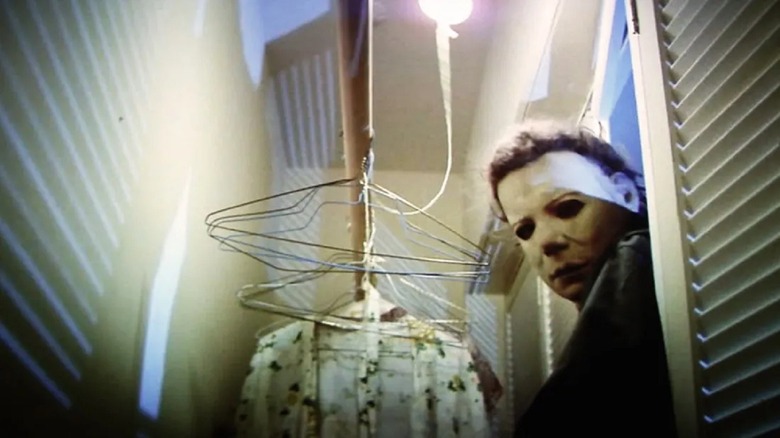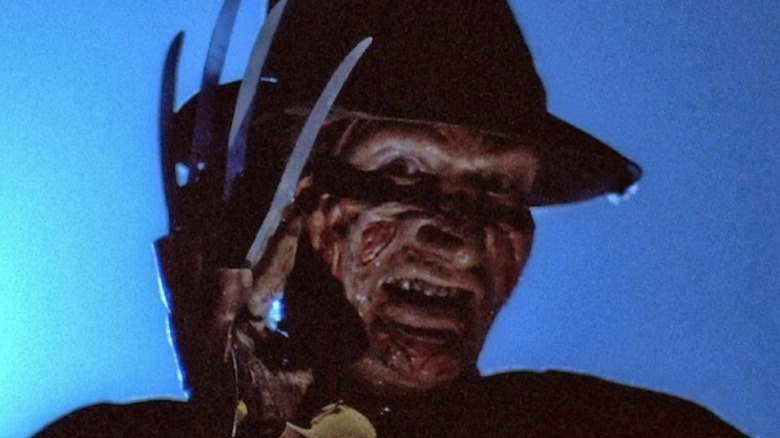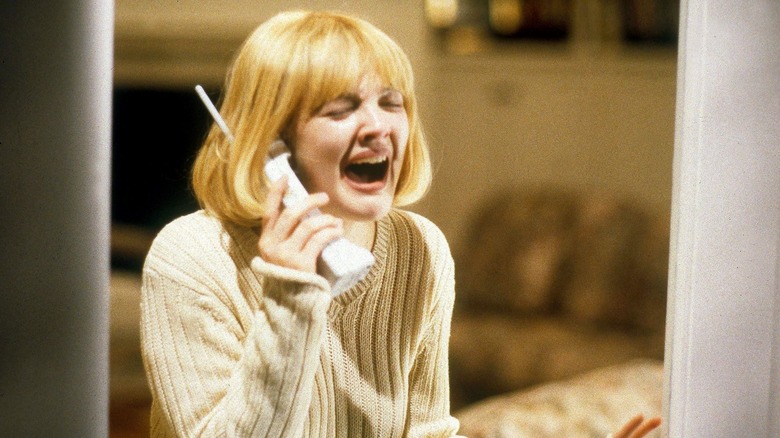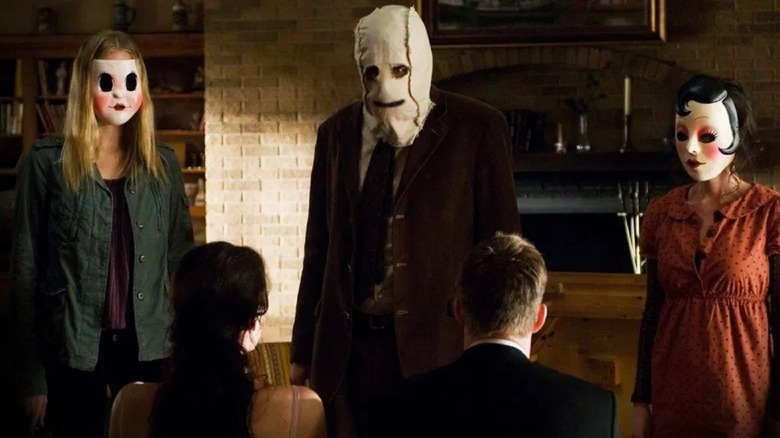The Evolution Of Slasher Films Explained
This content was paid for by Netflix and created by Looper.
It doesn't matter if you were a '90s kid who grew up reading R.L. Stine's books under the covers with a flashlight every night, or if you're new to the series. The new "Fear Street" trilogy, which brings Stine's chilling teen novel world to the screen for the first time, is a true treat for horror fans, particularly those with a fondness for slasher flicks. In the first film in the new series, a group of teens who live in a town plagued by violent murders delve into the decades-long mystery after brutal slayings rock the local mall. This story is set in 1994, and in addition to introducing some extraordinary villains, blood-curdling death scenes, and a group of highly resourceful kids, the film is also a pastiche of the best horror films of that era. The stylized settings. The look of the knife-happy villains. The first "Fear Street" film shines in its clever use of the familiar, even while telling a wholly new story.
In its second installment, the "Fear Street" trilogy recalls another era of slasher film history, focusing on a summer camp adventure gone very, very wrong. Like the first movie, the second "Fear Street" chapter fuses an homage to some of the most supreme slasher films of the past and present with a new narrative that'll knock your socks off. So, in the spirit of the "Fear Street" trilogy's unique celebration of slasher cinema, here's a look at how this deliciously grisly genre has evolved over time.
Early international influences
It's not easy to pin down which film qualifies as the very first slasher pic, but Germany's "krimi" films and Italy's giallo pics are some of the earliest examples of cinema that paired crime stories with the bloodshed that became a slasher genre staple.
Many of the "krimi" films ("krimi" is short for "kriminalfilm," or "crime film") of the late '50s and '60s are based on the works of British novelist Edgar Wallace, and like modern slasher films, focus on elusive and powerful masked villains. In fact, in these films, the bad guys are so important that they often appear in the movies' titles, as with 1959's "Face of the Frog" and 1967's "Creature with the Blue Hand." In addition, these movies also tend to feature stock casts that parallel those of slashers: there's usually a female protagonist, a comedic relief character, a police officer who's central to the case, and a group of victims who get picked off one by one. Finally and most importantly, the movies also include scenes of vicious violence, especially once color photography became more readily available, opening up moviemaking's macabre possibilities.
Though the "krimi" movies weren't beholden to a specific genre, they were highly influential in the development of the slasher. The Italian giallo films of the '60s and '70s, for example, were directly influenced by the "krimi" pics. In fact, some of the movies that are credited with belonging to the giallo tradition are actually partly German productions, like 1972's "What Have You Done To Solange?" Like the "krimi" pictures, giallo films often focus on a murder investigation featuring a masked killer, but they ratchet the gore and sexuality up significantly, creating a distinct new vein of horror film.
Mario Bava's films in particular are essential giallo fare. Bava's 1963 picture "The Girl Who Knew Too Much" is less graphic than some of its successors, but clearly establishes the genre's structure, as a protagonist attempting to unmask an at-large murderer all by her lonesome. Bava's next film, 1964's "Blood and Black Lace," was especially influential. The movie centers on a murderer who targets models, and its use of color and creative killing sequences is still shocking today. Another auteur whose contributions to the giallo genre can't be overstated is Dario Argento, who earned the nickname "Master of the Thrill" with gory films like "Deep Red" and "Opera," which is considered one of the best slasher movies ever made.
The rise of the psychos
In the U.S., Hollywood's horror history began all the way back in the late 19th Century with the three-minute silent film "The House of the Devil." Horror has been a popular genre ever since, and throughout the early 20th Century, many classics emerged, most of which focused on a classic monster or some sort of supernatural scare.
However, films with a murder or mystery at the center eventually gave rise to the tropes associated with modern slasher movies. 1932's "Thirteen Women" featured sorority sisters at the center of a sinister revenge scheme. 1946's "The Spiral Staircase" utilized then-novel jump scares as it followed a woman stalked by gloved killers. 1953's "House of Wax," which became a box-office smash thanks to its use of 3D, featured a burn victim-turned-murderer who transformed his prey's bodies into keepsakes.
The year 1960 in particular is often pointed to as the real starting point of the modern-day slasher, though, thanks to the premiere of both Alfred Hitchcock's "Psycho" and Michael Powell's "Peeping Tom." Both of these films centered on male murderers — Norman Bates and Mark Lewis, respectively — whose psychopathic tendencies stem from their relationships with their parents, and who take their worst impulses out on unsuspecting women.
While "Psycho" is especially famous for its unforgettable shower sequence, the focus on the voyeuristic nature of the villain in "Peeping Tom" is equally as unsettling. Although both films are also categorized as psychological thrillers, they helped establish the stabby baddie as a movie mainstay. No longer did killers need to be mythical creatures or barely-seen mystery men. After Norman and Mark, films were officially free to let their villains — and their weapons of choice — take center stage. Between these movies and the growing popularity of gruesome giallo films overseas, slasher films as we know them were on the rise by the early '70s.
A deadly new dawn
For many horror fans, the 1970s mark the true start of the slasher subgenre. Movies of the era were clearly influenced by the style and the story structure seen in the classic "krimi" and giallo films, and giallo films themselves were becoming increasingly slasher-like during this time period. In addition, the way that "Psycho" and "Peeping Tom" put a lens on their villains is clearly seen in the horror films that followed. In fact, one of the things that made the '70s such a significant decade for slashers is how films of that time period introduced so many lasting horror villains.
The '70s also saw its slasher pics establishing new norms for the genre, including the rise of holiday horror. Both 1972's "Silent Night, Bloody Night" and 1974's "Black Christmas" are early examples of horror films that turned holiday celebrations into bloodbaths. In "Silent Night, Bloody Night," a small town's Christmas Eve is filled with terror instead of tinsel after a man inherits a mansion that used to be an insane asylum. "Black Christmas" is based on a long-standing urban legend, showing the plight of coeds students who are stalked by a killer who makes phone calls from inside their sorority house. That basic concept was also used in the 1979 mystery-thriller "When a Stranger Calls," but because of the sheer volume of its viciousness, "Black Christmas" is the movie that's widely regarded as one of the first true slasher pics.
The same year that "Black Christmas" was released, Tobe Hooper's classic "The Texas Chain Saw Massacre" came along and redefined fright films forever. The pic was loosely inspired by the crimes of real-life serial killer Ed Gein and pushed the already-established notion of a masked killer with a signature weapon into terrifying new territory, ensuring that an entire generation of kids would give a wide berth to chainsaws. The film's villain, Leatherface, was merciless and relentless and had a pure, sickening sense of bloodlust. "Texas Chain Saw" was also one of the first films to use the "final girl" trope, in which a young girl emerges as the serial killer's sole survivor. Really, though, it's Leatherface's mysterious mercilessness that defines "The Texas Chain Saw Massacre" and makes it an all-time great.
"Black Christmas" directly inspired another one of the most significant slashers of all time, John Carpenter's 1978 classic "Halloween." "Black Christmas" director Bob Clark himself gave Carpenter the initial concept for the film, telling the then-up-and-coming writer-director his concept for a sequel: a villain would escape from a mental institution and begin the sorority house mayhem anew around Halloween. Thus, Michael Myers was born.
But even though "Halloween" is a descendant of "Black Christmas," Carpenter's flick still stands on it own, coupling the trend of a holiday-gone-wrong with a stalker in the vein of Leatherface. The film introduced audiences to its tireless killer Michael Myers — who, by the way, sports a William Shatner mask that was initially made for "Star Trek" — who stalks his unsuspecting sister Laurie Strode (portrayed by Jamie Lee Curtis, the daughter of "Psycho" star Janet Leigh) and terrorizes babysitters with his kitchen knife in the small town of Haddonfield, Illinois. Like Leatherface before him, Michael Myers is ruthless and determined and very, very hard to kill, and he served as second in a succession of new masked murderers who spawned decades-long horror film franchises.
Other standout slashers of the '70s include "The Toolbox Murders," "Alice, Sweet Alice," and "Killer's Moon." And yet, in the '70s, things were just getting started. The decade that followed brought even more slasher fun to the film world.
A smattering of new slashers
After the '70s brought slashers into the mainstream, the '80s and early '90s became a heyday for the horror subgenre. With names like Leatherface and Michael Myers inspiring true terror throughout the film-watching world, the era of creative villains taking center stage was at a peak, and soon several other vicious baddies began haunting everyone's nightmares.
In 1980, "The Last House on the Left" producer Sean S. Cunningham took note of the success of "Halloween" and offered up his own killer concept with "Friday the 13th." Like "Halloween," "Friday the 13th" is about a group of teens terrorized by a mysterious killer, and it marked the start of a full-on franchise centered around its masked maniac, Jason Voorhees. It wasn't all repetition, though. At the time, "Friday the 13th" stood out thanks to its isolated and increasingly creepy summer camp setting, which was also employed in the 1983 franchise-starter "Sleepaway Camp." "Friday the 13th" also brought giallo-like sexiness to slashers, and helped establish slasher films' twisted moral codes, in which characters who are sexually active are those most likely to be targeted by the villain du jour. Both "Halloween" and "Friday the 13th" spawned a series of sequels that came out in quick succession, making both franchises box-office mainstays.
Soon after, writer-director Wes Craven earned the nickname "Master of Horror" with the release of 1984's "A Nightmare on Elm Street." Like "The Texas Chain Saw Massacre," "Halloween," and "Friday the 13th” before it, "A Nightmare on Elm Street" boasted an instantly iconic villain in Freddy Kreuger. But Freddy is quite different from his peers. Whereas Leatherface, Michael Myers, and Jason Voorhees were silent hunters, Freddy loves to taunt his victims. He even has a goofy, if morose, sense of humor. In addition, Freddy does not wear a mask, and he has a leaner body type than his hulking predecessors.
And yet, Freddy is just as scary as the rest of them. In fact, the very concept of "Nightmare on Elm Street" widened the playing field in ways that literally gave audiences nightmares. While Leatherface was confined to his remote Texas town, Michael Myers tended to lurk near his sister, and Jason Voorhees waited for his unfortunate marks to head to Camp Crystal Lake, Freddy stalked his victims in the dream world, giving him unlimited access to his targets. After all, they couldn't avoid sleep forever. Like its fellow slasher films, "A Nightmare on Elm Street" also received a number of sequels, the second of which is especially incredible.
The concept of a playful but terrifying killer like Freddy Krueger gave rise to other villains with cheeky personas, including the psychotic doll Chucky from 1988's "Child's Play" and the title antagonist in 1992's "Candyman." "A Nightmare on Elm Street" also made Wes Craven's reputation as a slasher maestro, opening the door for the writer-director to kick off a new horror subgenre about a decade later.
The self-referential era
After 1987's "A Nightmare on Elm Street 3: Dream Warriors," Wes Craven temporarily stepped away from the franchise, which came to an apparent conclusion with 1991's "The Final Nightmare." But when Craven did return to "Nightmare"-land, he was equipped with a very different vision. In 1994's "Wes Craven's New Nightmare," "A Nightmare on Elm Street" actress Heather Langenkamp plays a fictional version of herself who's tormented by a supernatural version of Freddy Krueger. For help, she has to turn to Craven himself, as well as actor Robert Englund, who portrayed Freddy in the prior films. This novel narrative marked the start of a self-aware era of slashers that Craven continued with his 1996 hit, "Scream."
"Scream" breathed new life into the slasher genre and brought a new generation of horror fans into the fold by embracing — and consciously subverting — slasher movie tropes. While the film continued some of the traditions of old, like mystery callers and masked killers, the film is also full of tongue-in-cheek references to past slasher movies. Throughout the movie and its many sequels, Craven layers a running commentary about the so-called "rules" of slasher flicks, like the sex-equals-death trope and the "never ... assume the killer is dead" jump scare tactic, on top of the action itself. The victims in "Scream" have seen slasher movies before and react accordingly, while the villains are horror film buffs who are trying to subvert the genre's built-in expectations.
Thanks to "Scream," teen slashers were suddenly all the rage again. 1997's "I Know What You Did Last Summer," which was written by "Scream" scribe Kevin Williamson and inspired by '80s slashers like "Prom Night" and "The House on Sorority Row," was another slumber party favorite. The '90s were also full of sequels to slasher movie staples, including "Halloween: H20," which put a new generation of teen heartthrobs at the center of the action. The 1998 pic "Urban Legend" was another movie that was in on its own joke, modeling its series of scares after urban legends of old, while 2000's "Final Destination" took the slasher subgenre into bold new territory, featuring a teen who experienced a premonition and cheated death, only to be hunted down alongside the others who were saved by his foresight.
The sprawling subgenres
Nowadays, the slasher subgenre has become a bit more flexible. A few recent slasher movies defy the tradition of a single blade-wielding baddie, and many incorporate tropes from other subgenres, often with great success. 2000's "American Psycho," for example, features a deranged killer and the kind of grisly murder sequences that you'd find in a slasher, but it's really a psychological thriller at heart. French films like "High Tension" and "Martyrs" also belong to multiple categories, despite having many slasher elements. Thrillers like 2003's "Wrong Turn" and 2013's disgusting "The Green Inferno" pushed boundaries with their cannibal-focused content, while movies like 2004's "Saw" and 2005's "Hostel" are part a post-millennial trend that plays up torture, gore, and violence. "The Purge" combined slasher movies with dystopian fiction, creating political horror stories, and let's not forget that slashers also couple nicely with spoof films, as seen in the "Scary Movie" franchise.
Perhaps most prominently, computer-generated imagery and improved special effects have made on-screen gore more dynamic than ever before, which means there's been a major uptick in splatter-style pics of late. Even movies that might traditionally be slashers, like the 2003 reboot of "The Texas Chainsaw Massacre," find themselves leaning toward the splatter zone thanks to their digital visual effects.
However, some more straightforward slashers have still made a splash recently. 2008's "The Strangers," for example, is a gnarly home invasion story that recalls vintage slasher films like "Black Christmas" and "Halloween." The same can be said for the 2016 pic "Hush," which takes the concept of a woman being terrorized by a masked killer in her home and gives it an exhilarating new twist. Other recent slashers that commit to a classic structure include 2014's "The Guest," 2011's "You're Next," and 2016's "Terrifier."
Recently, though, there's been a second wave of self-referential — and, sometimes , straight-out comedic — slasher films, including "Happy Death Day," "Freaky," "The Babysitter," and "Ready or Not," all of which infuse some levity into a familiar story structures. The new "Fear Street" films follow in this newfound tradition. They're completely terrifying, and filled with gnarly killers who will stop at nothing to finish their terrible deeds, but they also add some humorous commentary about the slasher subgenre and all the grisly goings-on. As the thrills continue with the third installment of "Fear Street," the trilogy ratchets up the scares and surprises even further, while also honoring slasher history in its own, unique way.
